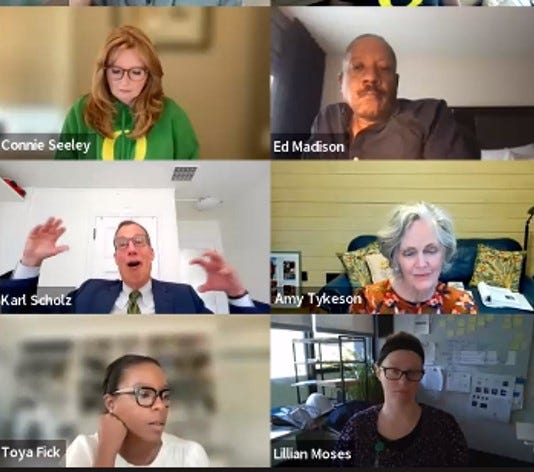The University of Oregon President finally said the quiet part out loud (while waving his arms)
And like many of his board members, we weren't listening

Conference realignment decisions made by university presidents in recent years make some sense to college football fans.
West coast football programs and players lack exposure to media markets east of the Mississippi. This in turn impacts subjective rating systems that select teams for playoffs and individual players for end-of-season awards. This has been a gripe for years. Playing in the central or eastern time zones fixes that problem.
The pursuit of high value media contracts in conference realignment also makes some sense to football fans (at least they did at first). Texas and Oklahoma skipped out on the Big 12 for a geographical match with the SEC with more money. The first teams from the Pac 12 to jump east (USC & UCLA) increased their annual media revenue by nearly $40 million a year with a full share of the Big 10’s media contract.
Then something weird happened.
Universities started exiting the Pac 12 for partial shares that were similar or less than what the Pac 12 was likely to receive. Stories about the Pac 12 demise to date have not considered this trend, instead focusing on the incompetency of Pac 12 university presidents to secure a media contract. But what if the presidents weren’t incompetent? What if, from their viewpoint, they got it right and the lack of a Pac 12 media contract is a convenient distraction?
University of Oregon President Karl Scholz knows he got it right.
During the nine minute zoom board meeting where the invitation to the Big 10 is accepted by Oregon, Scholz started by reciting a series of talking points (to board members who clearly were briefed ahead of time). Before calling the roll he was prompted by a board member zoomed in from a golf course to add something important. This is when President Scholz leaned backed in his chair and started waiving his arms in excitement (at 6:25 mark) and added, “I’m getting really enthusiastic comments from our director of enrollment management; ‘Karl, I wasn’t really involved in this, but this is AWESOME!’”1
“Awesome” is a word that rarely appears in discussions around the demise of the Pac 12 so it is worth unpacking the perspective of the president and his enrollment management department.
Is the “O” for Out-of-State University?
Universities in the Pac 12 operate with annual budgets ranging from one to eight billion dollars a year, with University of Oregon, Washington State and Oregon State at the low end and USC and Stanford at the high end. Media revenues are a tiny fraction of a university’s income.
Annual student tuition ranges from $9,000 a year at Utah for in-state residents to $68,000 at USC for all enrollees. All public universities in the Pac 12 charge different tuition rates for in-state and out-of-state residents. For public universities, increases in out-of-state enrollment offers more revenue and less dependence on contributions from state budgets. Look at the chart below from the University of Colorado. Out-of-state tuition accounts for over 50% of their revenues.
President Scholz emphasized UO’s minimal state support in his talking points during the brief board meeting. According the the Cooke Foundation, the University of Oregon is one of just 11 universities with a majority of out-of-state enrollees.2
The Cooke Foundation’s study of out-of-state admission practices found some universities chose equally qualified wealthy out-of-state applicants over lower-income in-state residents (e.g. UCLA) and other universities took out-of-state applicants that could not qualify for more selective schools in their home states (e.g. Arizona). Here is a chart illustrating the Pac 12 tuition rates and out-of-state enrollment for first-year freshman (taken from the Cooke report).
With this context (out-of-state tuition can be more than 50% of a university’s revenue while media rights are less than 3%) it makes sense that universities don’t care much for media revenue, but are thrilled with out-of-state enrollment. Since the Cooke Foundation published their report, the University of Oregon’s out-of-state enrollment has climbed to an awesome 57%.
Recapping from 30,000 feet
Football fans on the west coast have complained about east coast bias for years and everyone seems to understand that organizations of all stripes are always looking for more money.
University presidents in the Pac 12 have connected the two for us through conference realignment. Pac 12 universities that play more games in the east will boost out-of-state enrollment, grow their budgets (and unfortunately increase student debt), while their college football fans enjoy a renewed sense of relevancy. In the end, despite all the plot twists and false narratives that were thrown against the wall to explain conference realignment, it appears the university presidents got exactly what they wanted They have lined up significant potential revenue from out-of-state students (while dodging critics of student debt) while making many of their football fans happy.
Maybe they’re smarter than we thought.
Warning: Please don’t try this at home. Addressing a University president by their first name can be dangerous.
State University No More: Out-of-State Enrollment and the Growing Exclusion of High-Achieving, Low-Income Students at Public Flagship Universities, Ozan Jaquette. Jent Cooke Foundation.





